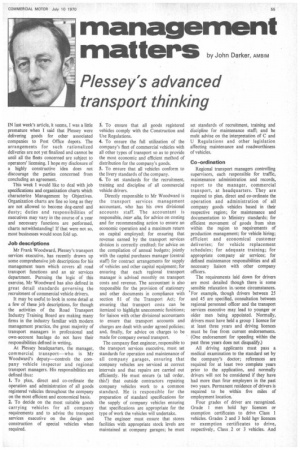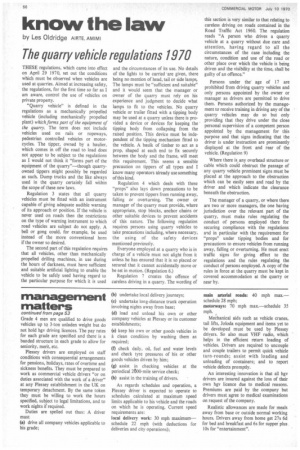management
Page 57

Page 58

If you've noticed an error in this article please click here to report it so we can fix it.
matters by John Darker, AMBIIVI
Plessey's advanced transport thinking
IN last week's article, it seems, I was a little premature when I said that Plessey were delivering goods for other associated companies to Post Office depots. The arrangements for such rationalized deliveries are not yet finalized and cannot be until all the fleets concerned are subject to operators' licensing. I hope my disclosure of a highly constructive idea does not discourage the parties concerned from concluding an agreement.
This week I would like to deal with job specifications and organization charts which characterize Management by Objectives. Organization charts are fine so long as they are not allowed to become dog-eared and dusty; duties and responsibilities of executives may vary in the course of a year and necessary functions are performed, charts notwithstanding? If that were not so, most businesses would soon fold up.
Job descriptions
Mr Frank Woodward, Plessey's transport services executive, has recently drawn up some comprehensive job descriptions for his management team which covers all road transport functions and an air services department. Pursuing the logic of this exercise, Mr Woodward has also defined in great detail standards governing the recruitment of commercial vehicle drivers.
It may be useful to look in some detail at a few of these job descriptions, for though the activities of the Road Transport Industry Training Board are making many firms in the industry familiar with modern management practice, the great majority of transport managers in professional and own-account haulage do not have their responsibilities defined in writing.
At Plessey headquarters, the manager, commercial transport—who is Mr Woodward's deputy—controls the company vehicle inspector and regional transport managers. His responsibilities are defined thus: 1. To plan, direct and co-ordinate the operation and administration of all goods registered vehicles throughout the company on the most efficient and economical basis.
2. To decide on the most suitable goods carrying vehicles for all company requirements and to advise the transport services executive on the design and construction of special vehicles when required. 3. To ensure that all goods registered vehicles comply with the Construction and Use Regulations.
4. To ensure the full utilization of the company's fleet of commercial vehicles with all other types of transport so as to provide the most economic and efficient method of distribution for the company's goods.
5. To ensure that all vehicles conform to the livery standards of the company.
6. To set standards for the recruitment, training and discipline of all commercial vehicle drivers.
Directly responsible to Mr Woodward is the transport services management accountant, who has his own divisional accounts staff. The accountant is responsible, inter cilia, for advice on costing and for recommending action to ensure an economic operation and a maximum return on capital employed; for ensuring that revenue earned by the transport services division is correctly credited; for advice on the compilation of annual budgets; jointly with the capital purchases manager (central staff) for contract arrangements for supply of vehicles and other capital equipment; for ensuring that each regional transport manager is advised monthly on transport costs and revenue. The accountant is also responsible for the provision of stationery and other documents in compliance with section 81 of the Transport Act; for ensuring that transport costs can be itemized to highlight uneconomic futictions; for liaison with other divisional accountants to ensure that transport accounts and charges are dealt with under agreed policies; and, finally, for advice on charges to be made for company owned transport.
The company fleet engineer, responsible to the transport services executive, must set standards for operation and maintenance of all company garages, ensuring that company vehicles are serviced at correct intervals and that repairs are carried out efficiently. He must ensure (a tall order, this?) that outside contractors repairing company vehicles work to a common standard. He is responsible for the preparation of standard specifications for the supply of company vehicles ensuring that specifications are appropriate for the type of work the vehicles wilt undertake.
The engineer must ensure that stores facilities with appropriate stock levels are maintained at company garages; he must set standards of recruitment, training and discipline for maintenance staff; and he mat advise on the interpretation of C and U Regulations and other legislation affecting maintenance and roadworthiness of vehicles.
Co -ordination
Regional transport managers controlling supervisors, each responsible for traffic, maintenance administration and records, report to the manager, commercial transport, at headquarters. They are required to plan, direct and co-ordinate the operation and administration of all company goods vehicles based in their respective region; for maintenance and documentation to Ministry standards; for efficient movement of goods from sites within the region to requirements of production management; for vehicle hiring; efficient and economical customer deliveries; for vehicle replacement schedules; for adequate training; for appropriate company air services; for defined maintenance responsibilities and all necessary liaison with other company officers.
The requirements laid down for drivers are most detailed though there is some sensible relaxation in some circumstances. For example, though drivers between 25 and 45 are specified, consultation between regional personnel officer and the transport services executive may, lead to younger or older men being appointed. Normally, drivers must have held a group 1 licence for at least three years and driving licences must be free from current endorsements. (One endorsement for speeding within The past three years does not disqualify.) All driving applicants must pass a medical examination to the standard set by the company's doctor; references are required for at least two complete years prior to the application, and normally drivers will not be considered if they have had more than four employers in the past two years. Permanent residence of drivers is required to be within five miles of employment location.
Four grades of driver are recognized. Grade I men hold hgv licences or exemption certificates to drive Class 1 vehicles. Grades 2 and 3 hold hgv licences or exemption certificates to drive, respectively, Class _2 or 3 vehicles. And
Grade 4 men are qualified to drive goods vehicles up to 34on unladen weight but do not hold hgv driving licences. The pay rates for each grade are specified and there is a banded structure in each grade to allow for seniority, merit, etc.
Plessey drivers are employed on staff conditions with consequential arrangements for pensions, holidays, rates of overtime and sickness benefits. They must be prepared to work as commercial vehicle drivers "or on duties associated with the work of a driver" at any Plessey establishment in the UK on temporary detachment. By the same token they must be willing to work the hours specified, subject to legal limitations, and to work nights if required.
Duties are spelled out thus: A driver must (a) drive all company vehicles applicable to his grade; (b) undertake local delivery journeys; (c) undertake long-distance trunk operation involving nights away from base; (d) load and unload his own or other company vehicles at Plessey or its customer establishments; (e) keep his own or other goods vehicles in a clean condition by washing them as required; (1) check daily, oil, fuel and water levels and check tyre pressures of his or other goods vehicles driven by him; (g) assist in checking vehicles at the periodical 2000-mile service check; (h) assist in the training of drivers.
As regards schedules and operation, a Plessey driver is expected to operate to schedules calculated at maximum speed limits applicable to his vehicle and the roads on which he is operating. Current speed requirements are: local delivery work: 30 mph maximum— schedule 22 mph (with deductions for deliveries and city operations); main arterial roads: 40 mph max.— schedule 28 mph; motorways: 70 mph max.—schedule 35 mph. , Mechanical aids such as vehicle cranes, tail lifts, Joloda equipment and items yet to be developed must be used by Plessey drivers. So also must VHF radio, which helps in the efficient return loading of vehicles. Drivers are required to uncouple and couple trailers to permit quick vehicle turn-rounds; assist with, loading and unloading of containers; and to report vehicle defects promptly.
An interesting innovation is that all hgv drivers are insured against the loss of their own hgv licence due to medical reasons. Premiums are paid by the company but drivers must agree to medical examinations on request of the company.
Realistic allowances are made for meals away from base or outside normal working hours. Drivers away from home get 27s 6d for bed and breakfast and 6s for supper plus lOs for "entertainment".












































































































